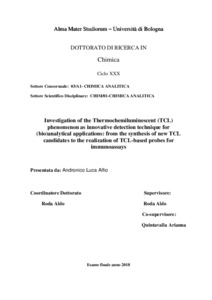Andronico, Luca Alfio
(2018)
Investigation of the Thermochemiluminescent (TCL)
phenomenon as innovative detection technique for
(bio)analytical applications: from the synthesis of new TCL
candidates to the realization of TCL-based probes for
immunoassays, [Dissertation thesis], Alma Mater Studiorum Università di Bologna.
Dottorato di ricerca in
Chimica, 30 Ciclo. DOI 10.6092/unibo/amsdottorato/8530.
Documenti full-text disponibili:
![[img]](http://amsdottorato.unibo.it/8530/1.hassmallThumbnailVersion/PhD%20thesis_Luca%20Alfio%20Andronico.pdf)  Anteprima |
|
Documento PDF (English)
- Richiede un lettore di PDF come Xpdf o Adobe Acrobat Reader
Disponibile con Licenza: Salvo eventuali più ampie autorizzazioni dell'autore, la tesi può essere liberamente consultata e può essere effettuato il salvataggio e la stampa di una copia per fini strettamente personali di studio, di ricerca e di insegnamento, con espresso divieto di qualunque utilizzo direttamente o indirettamente commerciale. Ogni altro diritto sul materiale è riservato.
Download (4MB)
| Anteprima
|
Abstract
In the present PhD thesis, thermochemiluminescence (TCL) phenomenum as a new
promising tool for development of innovative (bio)analytical detection methods has been
investigated. The first part of this work was focused on the synthesis of new TCL
candidates, aiming the optimization of the TCL properties in terms of lower decomposition temperatures and higher fluorescence quantum yields of
the generated excited fragments. Moreover, through a chemometric
approach, both the structural and electronic molecular descriptors for each molecule
were analysed and used to elaborate a model able to predict the olefin photooxygenation
outcome. Moving forward, the focus was shifted to the realization of TCL-based nanosensors for immunoassay applications. In particular, the fabrication of both molecular and nanometric-scale probes was performed, linking the TCL substrate (1,2-dioxetane) directly to universal biomarker
or encapsulating it within a polymeric nanoshell. Concerning the molecular probe, acridin 1,2-dioxetane was functionalized with biotin in order to create a TCL sensor for detection of streptavidin-based targets. TCL process was, then, combined with the semiconductive polymer dots (Pdots) technology to realize ultrabright thermo-responsive nanoparticles able to detect biotinylated compounds of interest. In particular, the FRET mechanism occurring between the polymeric matrix of Pdots and TCL substrate has been exploited to both enhance the light generation and shift the emission towards longer wavelengths. Furthermore, TCL-Pdots were tested in a noncompetitive sandwich-type immunoassay for detection of Immunoglobuline G (IgG). The last part of this work was focused on the realization of a home-made portable device to combine TCL-based detection technique with smartphone technology. All the different items constituting the apparatus have been fabricated exploiting a 3D printing process and acrylonitrile-butadiene-styrene (ABS), as starting material. The device was tailored to the camera of a Nokia Lumia 1020 exploiting, thus, the performance of the complementary Metal Oxide
Semiconductor sensor of the smartphone’s camera.
Abstract
In the present PhD thesis, thermochemiluminescence (TCL) phenomenum as a new
promising tool for development of innovative (bio)analytical detection methods has been
investigated. The first part of this work was focused on the synthesis of new TCL
candidates, aiming the optimization of the TCL properties in terms of lower decomposition temperatures and higher fluorescence quantum yields of
the generated excited fragments. Moreover, through a chemometric
approach, both the structural and electronic molecular descriptors for each molecule
were analysed and used to elaborate a model able to predict the olefin photooxygenation
outcome. Moving forward, the focus was shifted to the realization of TCL-based nanosensors for immunoassay applications. In particular, the fabrication of both molecular and nanometric-scale probes was performed, linking the TCL substrate (1,2-dioxetane) directly to universal biomarker
or encapsulating it within a polymeric nanoshell. Concerning the molecular probe, acridin 1,2-dioxetane was functionalized with biotin in order to create a TCL sensor for detection of streptavidin-based targets. TCL process was, then, combined with the semiconductive polymer dots (Pdots) technology to realize ultrabright thermo-responsive nanoparticles able to detect biotinylated compounds of interest. In particular, the FRET mechanism occurring between the polymeric matrix of Pdots and TCL substrate has been exploited to both enhance the light generation and shift the emission towards longer wavelengths. Furthermore, TCL-Pdots were tested in a noncompetitive sandwich-type immunoassay for detection of Immunoglobuline G (IgG). The last part of this work was focused on the realization of a home-made portable device to combine TCL-based detection technique with smartphone technology. All the different items constituting the apparatus have been fabricated exploiting a 3D printing process and acrylonitrile-butadiene-styrene (ABS), as starting material. The device was tailored to the camera of a Nokia Lumia 1020 exploiting, thus, the performance of the complementary Metal Oxide
Semiconductor sensor of the smartphone’s camera.
Tipologia del documento
Tesi di dottorato
Autore
Andronico, Luca Alfio
Supervisore
Co-supervisore
Dottorato di ricerca
Ciclo
30
Coordinatore
Settore disciplinare
Settore concorsuale
Parole chiave
thermochemiluminescence, immunoassay, semiconductive polymer dots, smartphone, nanoparticles
URN:NBN
DOI
10.6092/unibo/amsdottorato/8530
Data di discussione
17 Aprile 2018
URI
Altri metadati
Tipologia del documento
Tesi di dottorato
Autore
Andronico, Luca Alfio
Supervisore
Co-supervisore
Dottorato di ricerca
Ciclo
30
Coordinatore
Settore disciplinare
Settore concorsuale
Parole chiave
thermochemiluminescence, immunoassay, semiconductive polymer dots, smartphone, nanoparticles
URN:NBN
DOI
10.6092/unibo/amsdottorato/8530
Data di discussione
17 Aprile 2018
URI
Statistica sui download
Gestione del documento:


 Login
Login
